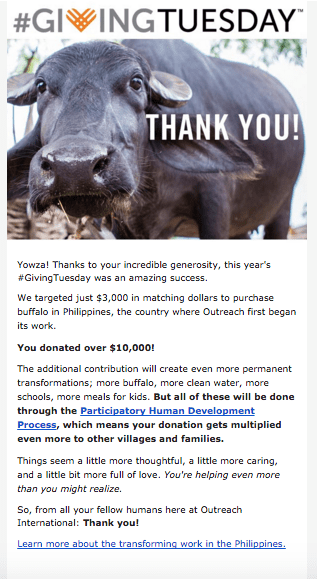6 Giving Tuesday Email Examples That Convert

Request a Demo
Learn how top nonprofits use Classy to power their fundraising.
In 2019, Giving Tuesday raised $1.97 billion in the United States, with online giving increasing 28% from 2018 to 2019. That total includes the $19,433,030 from 153,543 donors that Classy customers raised. The global event inspires millions of people to donate to causes they care about, and email marketing is one key strategy that can engage and encourage your audience to support your nonprofit.
See What Donors Want to See This Giving Season
The holiday season dramatically increases how many emails your supporters receive, though. Black Friday totals nearly 120 million sent, making it the year’s single-highest day for email volume. But with about 34% of donations made in the last three months of the year and email accounting for around a quarter of holiday revenue, this is a time to lean into this marketing channel.
Nonprofits shouldn’t hold back on email out of fear of overwhelming their supporters. Doing so can cause you to miss critical fundraising and stewardship opportunities. Rather, you must design Giving Tuesday emails that inspire someone to act.
Below, we cover six Giving Tuesday emails that convert in order to spark engagement, encourage action, and drive donations for your nonprofit. Each tactic is paired with a real-world example, where we’ll highlight what elements made it successfully convert.
Free Download: 10 Giving Tuesday Email Templates
1. Build Momentum With a Soft Launch
You’ve established your fundraising goal, set up your Giving Tuesday campaign page, and prepared your messaging cadence. Before officially launching to the full public, you should consider starting with a soft launch. This tactic allows you to test the efficacy of your plans in a safe environment where you can make small adjustments or tweaks as needed and start raising those dollars.
For a soft launch, you’ll want to reach out to your most devoted supporters about 2 to 3 weeks before Giving Tuesday. These supporters can include your recurring and long-time donors, volunteers, board members, and past Giving Tuesday participants. They have an established relationship with your nonprofit, which makes them more likely to commit early donations and be open to any feedback.
That, in turn, generates early momentum for your campaign. When you officially launch, potential donors will be more likely to give when they see you’ve already made significant progress toward your goal.
This is due in part to the goal proximity effect. It states that contributions toward a campaign are markedly higher when your nonprofit is 33% to 66% toward meeting its goal and even higher once it is 66% or closer.
In addition to alerting your audience about the soft launch, this email can help strengthen donor relationships. Receiving personal, early notice of your campaign makes supporters feel valued and appreciated, and the opportunity to take part in a special launch is a huge delight.
Example: Operation Warm
In the email below, Operation Warm announces that its Giving Tuesday event is just three weeks away.
It reminds the recipient of last year’s campaign success by speaking directly and personally to the supporter: “You helped the Firefighters for Operation Warm raise over $60,000.” This language makes the recipient feel like they played a part in your success last year and can do so again this year.
The email ends with a clear call to action through buttons supporters can use to add the Giving Tuesday event reminder to their calendars.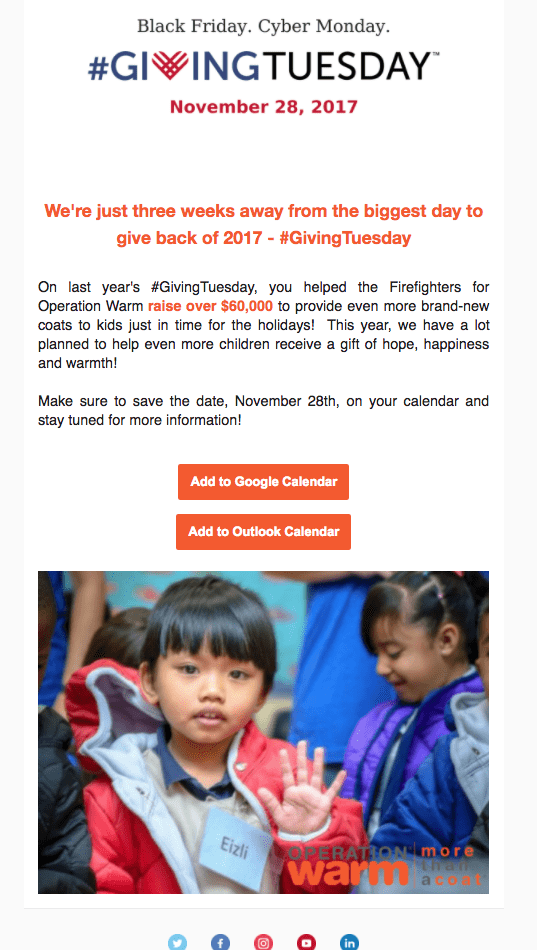
2. Make a Clear Ask
After you’ve built momentum through your soft launch and received feedback on your campaign, you’ll need to have your main donation appeal email ready to send.
Use an eye-catching subject line to grab the recipient’s attention. As a general rule of thumb, you want to keep your subject line under 50 characters, and ideally under 30, to be mobile-friendly. Front-load your cause’s message and follow with action. For example: Keep Kids Warm, Help Us Today.
The body of your email should include a brief introduction to the campaign using an emotional hook, a clearly stated fundraising goal with explanations on how donations make an impact, and linked text and buttons that stand out and lead to your donation page.
Example: The Trevor Project
In the example below, The Trevor Project clearly states its $100,000 fundraising goal in the email’s header and highlights it brightly. It uses a personalized salutation to help the recipient feel connected to the message.
The email uses just enough text so the supporter can quickly scan it to understand the impact of their support. It further guides the reader’s eye by strategically highlighting three instances of linked text to its donation page. It also includes a bright “donate” button midway through the email.
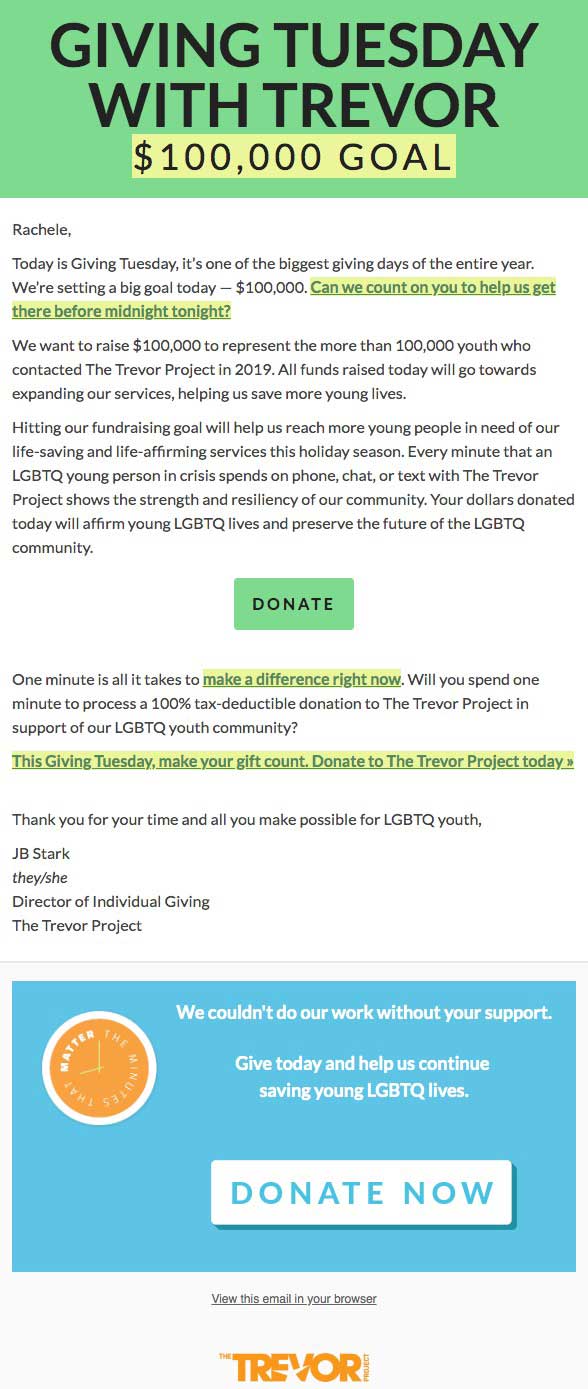
3. Highlight the Impact of a Matching Gift
The average donation amount for matched campaigns is 51% greater than those without a match, and the response rate to your appeals increases by 71%. Plus, a match can make supporters feel like their donation counts even more. If they give $25, it’s really $50. If they give $100, it’s really $200. They like to know they are doubling their impact.
In addition, it can be powerful to put a time restriction on your match. If you tell your supporters the match is only offered for a few hours during the campaign, that creates a sense of urgency that drives action toward meeting your goal. It also offers the opportunity for additional touchpoints through subsequent emails counting down the time, with subject lines like:
- Match Begins Now! Double Your Impact This Hour.
- Match 50% Over—Help Us Raise An Additional $10,000
- Time’s Running Out, But Still Time to Match Your Donation
- Match Complete, But There’s Still Time to Donate!
Example: Feeding San Diego
In this example of a time-limited matching campaign, Feed San Diego uses specific numbers to add an authentic element to the match. Rather than a perfectly rounded number, the email announces that Price Philanthropies will match every dollar up to $28,010.
It then clearly translates what that doubling of a supporter’s donation provides. Every $1 now provides eight meals instead of four. Give $50 to provide 400 meals, $250 to provide 2,000.
Finally, it adds a sense of urgency by including a countdown banner at the top of the email to show how much time is left to be part of the match’s impact.
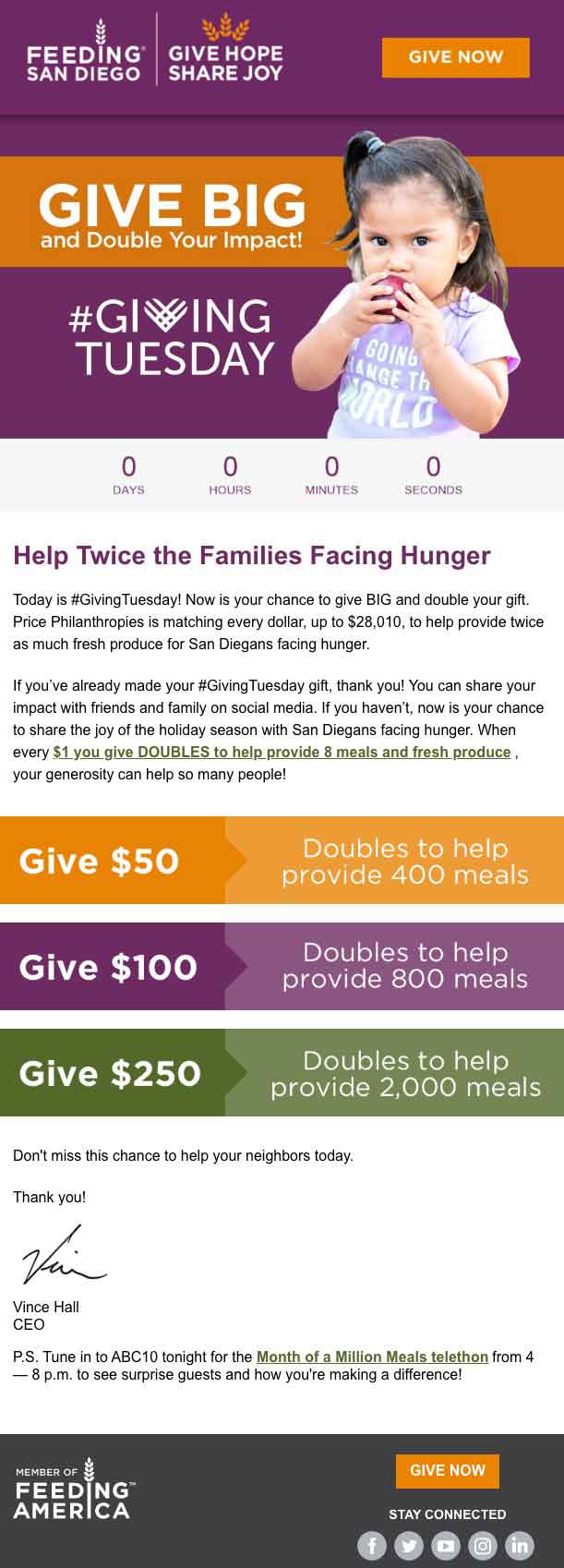
4. Personalize Appeals to Recurring Donors
You may think a recurring donor won’t give on top of their existing donation amount, but the data show otherwise.
Classy’s report The State of Modern Philanthropy 2020: Deconstructing the Online Donor Journey, found that recurring donors engage with multiple campaign types at higher rates than non-recurring donors. They are 75% more likely than one-time donors to make an additional one-time gift on top of their recurring subscription. In addition, their average one-time donation is higher at $150 versus $113 for non-recurring donors.
Free Download: The State of Modern Philanthropy 2020
By personalizing your Giving Tuesday appeals for your recurring donor segment, you can both thank them for their continued support and leverage the potential of an additional gift.
Get 8 Free Email Templates to Upgrade Your Recurring Donors
Example: Blink Now
In this example from Blink Now to one of its recurring donors, the nonprofit includes multiple acknowledgments of “your monthly support” right up front. This helps the supporter see that the nonprofit recognizes and appreciates their ongoing help. By referring to the monthly donation as “incredible” and “so important,” the email communicates the supporter’s special status with the nonprofit.
The email includes an embedded video as a bonus gift for the recurring donor. This media demonstrates the impact the donor has already helped make possible.
The message ends with a clear thank you coupled with an ask for an additional gift.
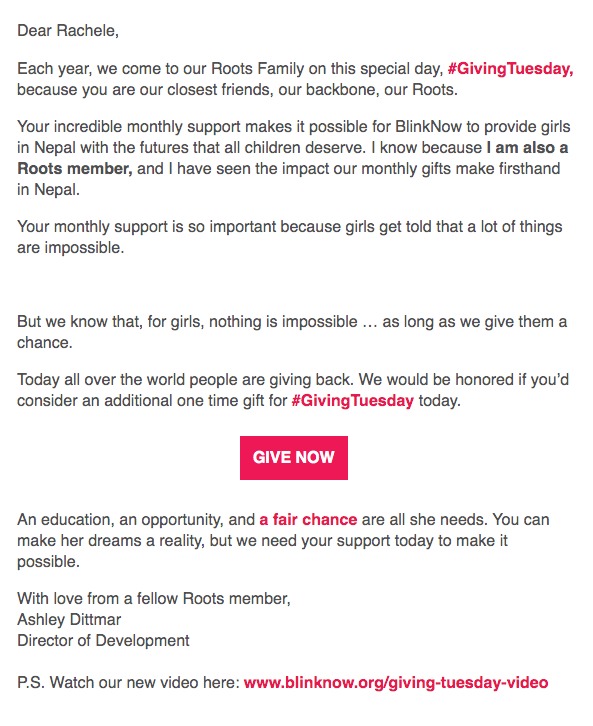
5. Send Progress Updates
Throughout the day, your nonprofit will share updates on social media, but it also helps to send a few well-timed updates via email, including one halfway through your campaign and another a few hours before it ends. People are more likely to give if they see you’re close to your goal, so updates allow supporters to tell that their support could really tip the scales.
Use These 10 Free Giving Tuesday Email Templates to Help
Example: Operation Broken Silence
In the email below, Operation Broken Silence uses specific numbers to show they are just over $100 away from reaching their goal. That amount is within range for one donor to make the key difference, which can encourage several to give.
The email uses the language “you’ve given” to express where the nonprofit is currently at in terms of reaching its goal. Even if the recipient of the email hasn’t donated yet, that phrasing can make them feel like they’re a part of this effort and more drawn to give.
Below a bold, clear donation button that highlights the generosity of taking action to give, the email encourages the recipient to “help us cross the finish line early.” This communicates to donors that they can not only reach the goal but overachieve this Giving Tuesday.
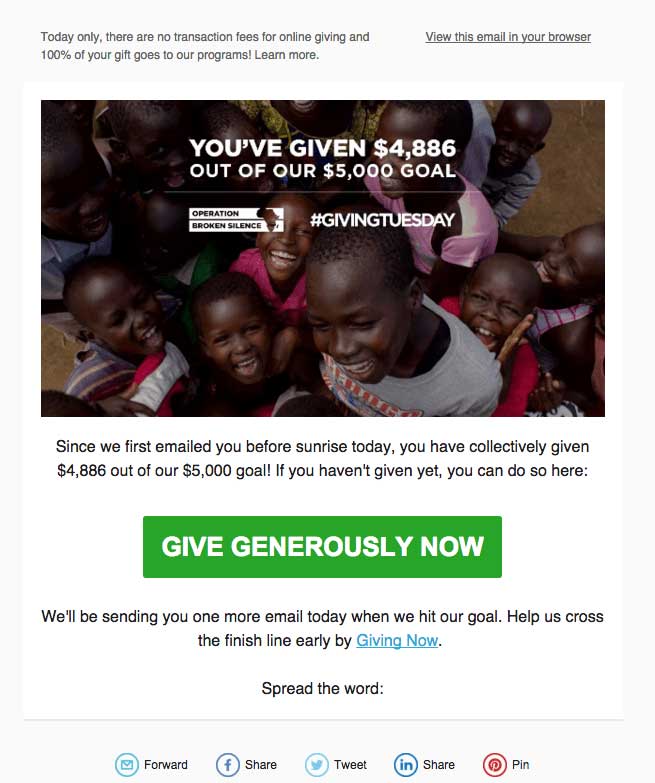
6. Remember to Say Thank You
Your supporters will want to know what impact your Giving Tuesday campaign had and the role they played in that. Send a follow-up thank you afterward that summarizes how much you raised and thanks the supporter for helping you reach your goal. Showcase specifically what activities your nonprofit will be able to pursue as a result of Giving Tuesday contributions.
You’ll want to send a thank you email that welcomes any first-time donors to your community. You should also send a personal thanks to recurring donors who participated to continue to affirm that relationship. Finally, you can say thank you more broadly through your social media channels, newsletter, or blog.
Example: Outreach International
The example below from Outreach International features a fun photo relevant to their fundraising goal of purchasing buffalo in the Philippines. It mentions the campaign’s $3,000 goal but highlights that incredible generosity raised over $10,000.
The email reiterates the nonprofit’s mission and how the funding will support it. It also contains links for supporters to learn more, encouraging continued engagement with the cause.
Strengthen Your Year-End Giving Strategy at the Leading Nonprofit Conference
Elevate Your Giving Tuesday Success With Thoughtful Emails That Convert
Following on the heels of Giving Tuesday is likely your year-end campaign. Once Giving Tuesday is over, you’ll want to highlight your campaign’s results in a series of intentional emails to demonstrate past success and build momentum for additional year-end giving. You can steward them to your next campaign by staying connected with everyone who donated.

10 Free Giving Tuesday Email Templates
Subscribe to the Classy Blog
Get the latest fundraising tips, trends, and ideas in your inbox.
Thank you for subscribing
You signed up for emails from Classy
Request a Demo
Learn how top nonprofits use Classy to power their fundraising.
 Explore Classy.org
Explore Classy.org 